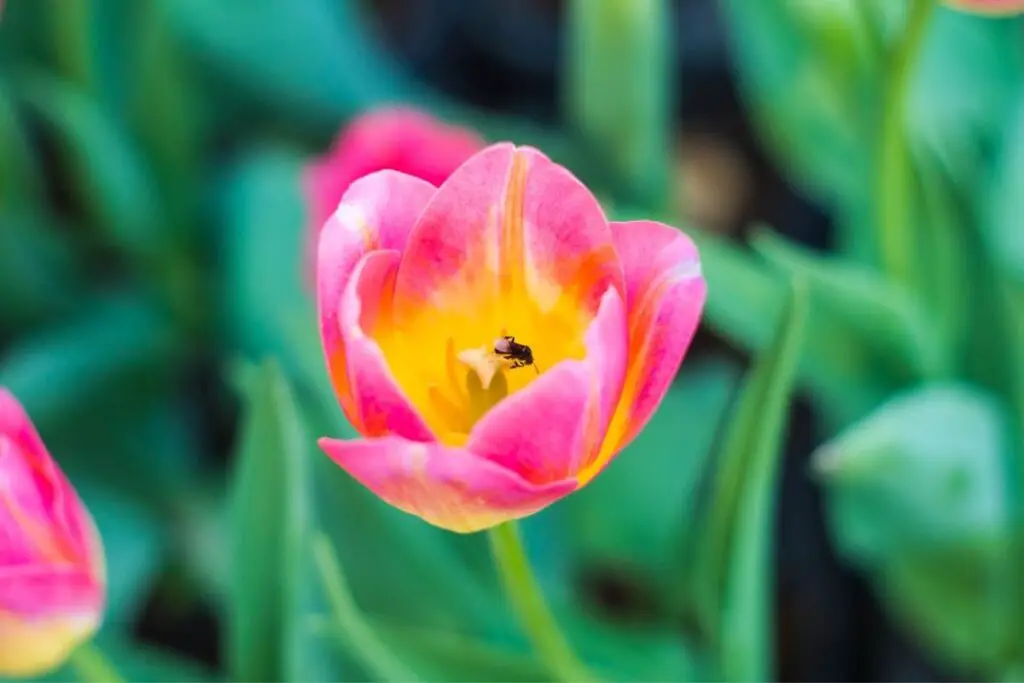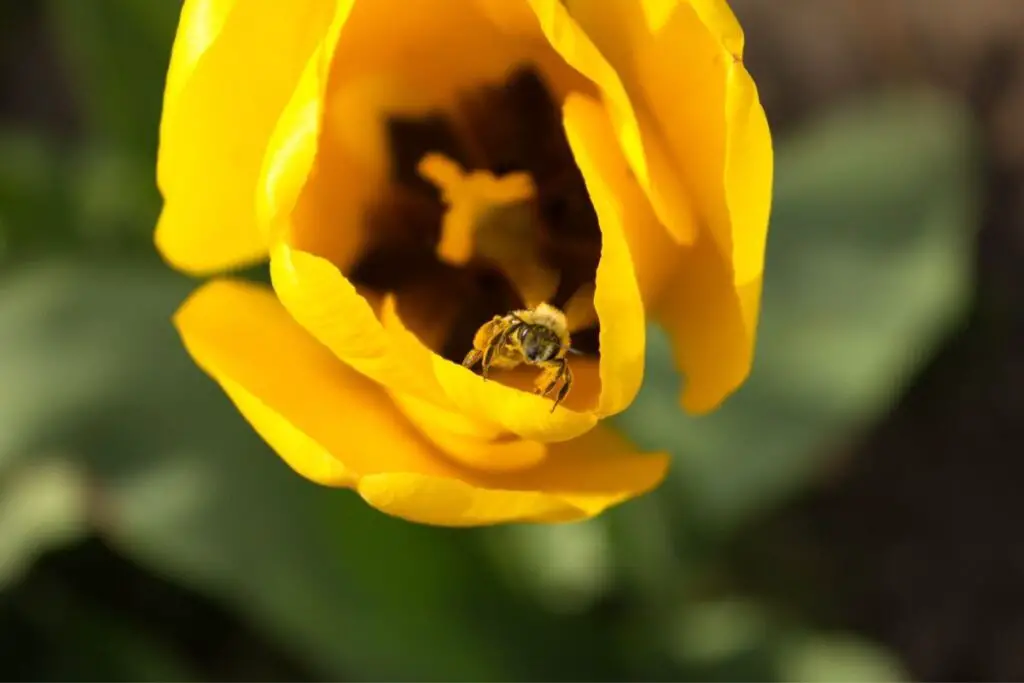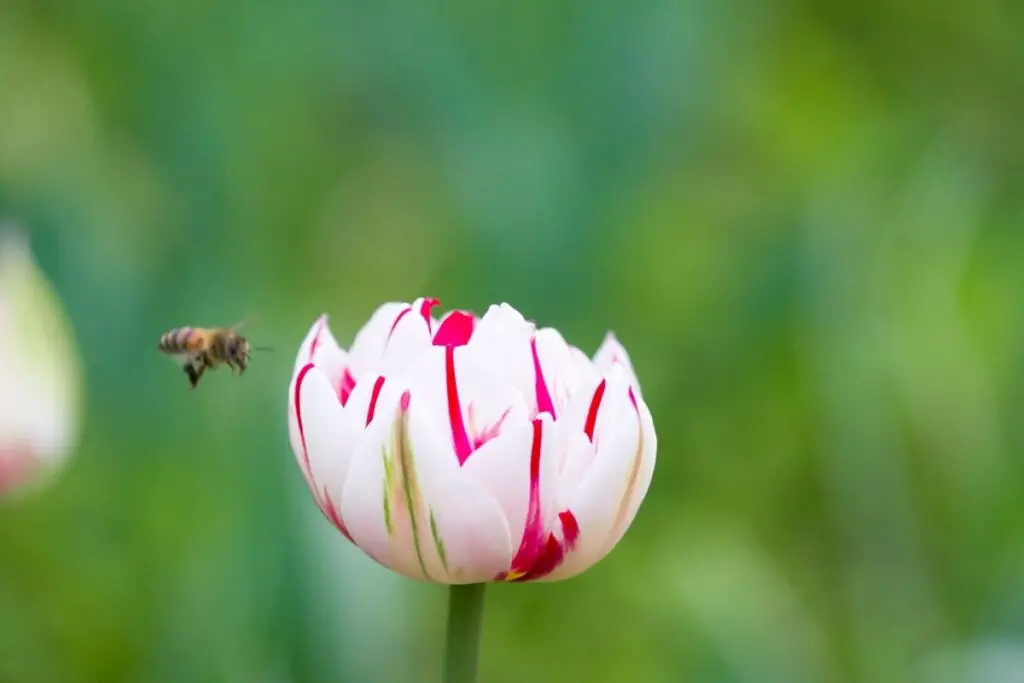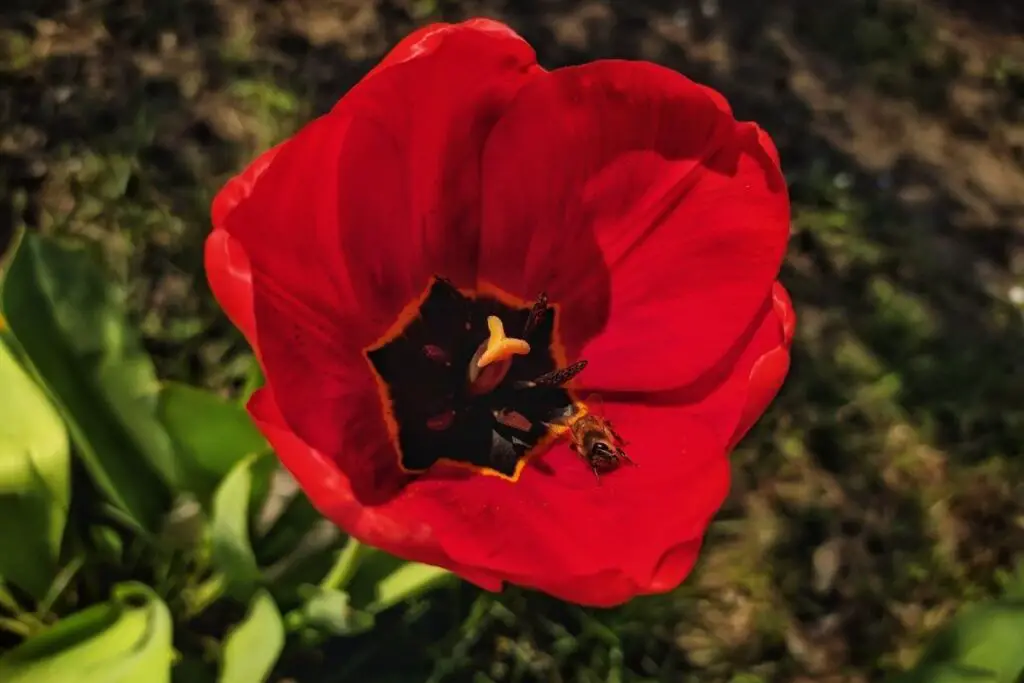While growing tulips in the garden, you might wonder whether bees or butterflies will visit them for pollination or not. Bees love colors, and as tulips are available in various colors, they should attract bees. Shouldn’t they?
So, let us understand if tulips attract bees or not.
As a general rule, Tulips can attract bees as they bloom early in the season and have vibrant colors. Tulips don’t have much nectar to offer to the bees, but some tulip varieties bloom in the early spring, providing some food to the bees who have come out of hibernation.
It is confusing whether bees like the tulips because growers say different things about their nectar production and pollen.
However, you don’t need to worry because, in this article, we have covered all information about tulip’s relation with bees.

Do bees like tulips?
One cannot confidently tell whether the bees will like the tulips, but bees will like tulips if they get their food from them.
Tulips have different varieties with different blooming times. Some bloom in early spring, some in mid-season, and some are late bloomers. So, if you grow the varieties that bloom in the early spring, bees will benefit from them.
Bees are in hibernation during the whole winter. When the winter ends, and spring arrives, they will be entirely at a loss of energy and starve for food.
If your garden has these early bloomers, the bees can visit and feed on the pollen and nectar. However, the tulips’ nectar count is low, but the pollen will benefit them.
Some people say the bees will not like tulips because they have a meager pollen count and zero nectar. Well, that is not entirely true. They have both pollen and nectar, although the nectar count is low.
Therefore, due to low nectar, honeybees can only feed themselves. They won’t collect enough nectar only from tulips to take back to their hive.
Because of this, if you are unsure whether the bees will visit your tulips or not, you can plant other bulb plants too, along with tulips, like Crocus, Daffodils, or Hyacinth.
How will bees benefit from tulips?
Bees will benefit from tulips because tulips will bloom in the early spring when bees will be starving and need food to regain their energy.
However, the life of bees doesn’t rely entirely upon tulips. There are other plants too, which can help bees get enough pollen and nectar. But the tulips can save the bees from dying of starvation.
Let’s see how tulips can benefit from tulips:
Early and easy access
It is said that bees face difficulty getting food from the tulips because there are low pollen and nectar. But that is not true.
Tulips flower from early spring to late spring, depending on the variety. As I said earlier, they have different varieties that bloom at different timing.
If you have tulips, you can notice the center of the flower. It will have black-colored anthers covered by pollen. Sometimes, tulips have a lot of pollens, and their dust covers the inner petals.
When the bees have just finished hibernating, they search for food to regain their strength. The early tulip bloomers are perfect for them. The bees can have easy and early access to food from these tulips.
The early bloomers will save the bees from dying.
As I said, bees have just completed hibernating after winter, starving. This is when the early tulips will flower and produce pollen and nectar.
However, the nectar might be very little, but the flowers will have enough pollen to help the bees from dying.
Pollen has a lot of nutrients and protein, which can be lifesavers for bees.
The early spring bloomers are Double Early, Fosteriana, Greigii, Kaufmanniana, and Single Early.
The tulip flowers that bees will get attracted to other than these early bloomers are Blue Ribbon Triumph Tulips and the late bloomer Bleu Amiable Single Late Tulips.
Looking for gardening supplies? We have tested 100's of products before recommending them to you guys. Check out our best pick below:
| Image | Gardening Supplies | Best Price? |
|---|---|---|
 Top
Top Top
Top | Raised Garden Bed Kit | Check On Amazon |
 | XLUX Soil Moisture Meter, Plant Water Monitor, Soil Hygrometer Sensor for Gardening, Farming, Indoor and Outdoor Plants, No Batteries Required | No Results |
 Top
Top Top
Top | 82 Pcs Garden Tools Set and Extra Succulent Tools Set | Check On Amazon |
 | Joeys Garden Expandable Garden Hose with 8 Function Hose Nozzle, Lightweight Anti-Kink Flexible Garden Hoses, Extra Strength Fabric with Double Latex Core, (50 FT, Black) | No Results |
 Top
Top Top
Top | Dual Chamber Compost Tumbler | Check On Amazon |
 Top
Top Top
Top | Sunnyglade Plant Stakes | Check On Amazon |
 Top
Top Top
Top | Organic Cold Pressed Neem Seed Oil | Check On Amazon |
 Top
Top Top
Top | Mighty Mint Gallon :-Insect and Pest Control Peppermint Oil | Check On Amazon |
 Top
Top Top
Top | Scotts DiseaseEx Lawn Fungicide | Check On Amazon |
 Top
Top Top
Top | Jacks Classic 20-20-20 All Purpose Fertilizer | Check On Amazon |
 Top
Top Top
Top | 30,000 Seeds Pollinator Attracting Wildflower Mixture | Check On Amazon |
 Top
Top Top
Top | Survival Vegetable Seeds Garden Kit-Over 16,000 Seeds | Check On Amazon |
Will bees get attracted to tulip flowers?

Bees use different kinds of strategies to survive in winter. But, after winter, when the spring arrives, all the bees will be out of hibernation and search for food and begin their next lifecycle phase.
They will need both pollen and nectar. The bees will require pollen because it has a lot of nutrients and protein, giving the bees a lot of energy. The nectar will give the bees fast carbohydrates.
Honeybees will need enough nectar because it is their food which they will keep collecting and storing from different flowers for winter.
Generally, it is said that because tulips produce an insufficient quantity of nectar, insect pollination is not possible. Thus, the bees will also not get attracted to the tulips to that much extent.
Despite having a solid reason behind tulips not being attractive to bees, there are some obvious reasons why the bees can get attracted to tulips. They will only like it if they find them to be attractive.
Firstly, the bees will get attracted to the dark-colored tulips. They can see the UV rays in the petals. Secondly, tulips have a lot of colors. They will get attracted by beautiful and bright colors.
And thirdly, the tulip flowers remain wide open. Tulips grow by over-wintered bulbs. So, these vast, large flowers from over-wintered bulbs will attract the bees.
Other than these reasons, you can do something by which the tulips might attract bees.
Plant a wide range of colorful tulips
If you want different types of bees to come to the tulip garden, you can plant various tulips. As tulips are available in various colors, it won’t be tough to have different colors. Moreover, different varieties bloom at different times.
The whole spring, the bees will keep visiting your tulip garden bed. They will not just help themselves but also help pollinate.
Some pollen will get attached to their body. The attached pollen will drop in those other tulips when they shift to other tulips. This will help in reproduction.
Planting a variety of colors will attract more bees to your tulip garden bed.
Consider other pollinators along with bees

If you plant a wide range of colorful tulips, honeybees, mason bees, and bumblebees will travel in your garden. The honeybees travel up to 3 miles from their nest to collect pollen and nectar.
The bumblebees forage will travel within a mile of their colony. The mason bees won’t go much far. They travel only 300 feet from their nest.
Plant other companions to attract more bees
Tulips do have pollen but have very little nectar. Due to lack of nectar, if the bees visit less in your tulip garden, you can add other flowering plants. This will increase the bees’ visiting frequency.
Flowers like Hyacinths, Crocus, Daffodils, Allium, and Snowdrops produce pollen and nectar. Bees will easily get attracted to your garden seeing so many colors, and they will also get their food in large quantities.
Are tulips good for bees?
Yes, tulips are good for bees because they will kick away their starvation by feeding on the tulips after they finish hibernating.
Once the winter gets over, the bees will start emerging out of their nest and roam about for food. When they end hibernating, they will feel weak and drained out.
As the tulips are early spring bloomers, they can help them with food, nectar, and pollen. This will help the bees to regain their strength and energy.
Thus, in this sense, tulips are good for bees.
But, tulips are also, at one point, not beneficial for bees. Tulips don’t produce a vast amount of nectar. So, the honeybees won’t collect enough nectar for storing in their hives.
In this case, you can say that tulips are not that good for honeybees.
Some specific tulips will be best for bees. The violet-shaded tulips are best for them. The ultraviolet rays in the petals will be visible to the bees.
Exceptionally, the Purple Prince Single Early tulips, the Blue Ribbon Triumph Tulips, and the late bloomer, the Bleu Amiable Single Late Tulips, will be best for the bees.
Are tulips bee-friendly?

It isn’t evident whether tulips are bee-friendly or not. Even though tulips produce both pollen and nectar, they are not considered bee-friendly to that extent. This is because tulips don’t produce enough nectar.
Tulips can bloom as early as late winter. So there will be some flowers left wide open for attracting bees. So, again here the tulips will be proved bee-friendly. This is applicable in the case of pollen.
Tulips tend to produce a good amount of pollen.
The bees will get attracted to tulips by their color and will like them because of pollen. The bees feed on the pollen to gain energy after finishing hibernation. Considering the whole thing, the tulips can be called bee-friendly.
You can create a bee-friendly surrounding though in your garden. Grow many different colored tulips in your garden. Include the early, mid, and late bloomers.
With tulips, you can also plant other colorful bulbs flowers that produce enough nectar and pollen, like Crocus, Hyacinths, Daffodils, Snowdrops, Allium, etc.
Will bees pollinate tulips?
Due to the absence of nectar, tulips rely less on bees and mostly on animals, birds, and winds. But, due to their attractive colors and wide flowers, the bees will give them a visit and help pollinate.
While they feed, the nectar gets siphoned up internally, which means they have fed on it. Some pollen is fed for it provides the bees with protein and nutrition. Some pollen from the flower’s male reproductive organ will attach to their bodies and legs.
While the bees travel between the tulip flowers, they carry the attached pollen. When they sit on another tulip flower, the pollen will roll off the bees’ bodies and fall on the female reproductive organ. That is how they pollinate tulips.
Final thoughts
Both tulips and bees are good for each other. Bees will visit tulips if they find them attractive. If they get enough food, they will even like them. In return, the bees will help the tulips pollinate.
But I would say that they will like tulips. This is because they are early spring bloomers, and when the bees get out of hibernation, the tulips will help them at least with enough pollen and some nectar.
Both tulips and bees love sunlight. The bees will love having these bulb flowers near them in the summers. It will help them survive on hot days.
You can attract more bees by planting colorful tulips.
Along with it, try other flowering bulbs too. It would help to attract more bees. When bees and butterflies keep traveling in your garden, it means that there is a proper balance, and of course, your plant is healthy.
Source: Wikipedia, North Dakota Stae University, The Royal Horticultural Society.
